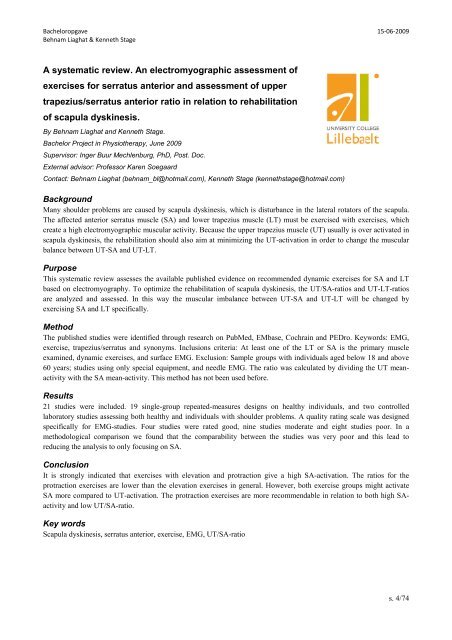Behnam Liaghat & Kenneth Stage - Zendegi.dk
Behnam Liaghat & Kenneth Stage - Zendegi.dk
Behnam Liaghat & Kenneth Stage - Zendegi.dk
You also want an ePaper? Increase the reach of your titles
YUMPU automatically turns print PDFs into web optimized ePapers that Google loves.
Bacheloropgave 15-06-2009<br />
<strong>Behnam</strong> <strong>Liaghat</strong> & <strong>Kenneth</strong> <strong>Stage</strong><br />
A systematic review. An electromyographic assessment of<br />
exercises for serratus anterior and assessment of upper<br />
trapezius/serratus anterior ratio in relation to rehabilitation<br />
of scapula dyskinesis.<br />
By <strong>Behnam</strong> <strong>Liaghat</strong> and <strong>Kenneth</strong> <strong>Stage</strong>.<br />
Bachelor Project in Physiotherapy, June 2009<br />
Supervisor: Inger Buur Mechlenburg, PhD, Post. Doc.<br />
External advisor: Professor Karen Soegaard<br />
Contact: <strong>Behnam</strong> <strong>Liaghat</strong> (behnam_bl@hotmail.com), <strong>Kenneth</strong> <strong>Stage</strong> (kennethstage@hotmail.com)<br />
Background<br />
Many shoulder problems are caused by scapula dyskinesis, which is disturbance in the lateral rotators of the scapula.<br />
The affected anterior serratus muscle (SA) and lower trapezius muscle (LT) must be exercised with exercises, which<br />
create a high electromyographic muscular activity. Because the upper trapezius muscle (UT) usually is over activated in<br />
scapula dyskinesis, the rehabilitation should also aim at minimizing the UT-activation in order to change the muscular<br />
balance between UT-SA and UT-LT.<br />
Purpose<br />
This systematic review assesses the available published evidence on recommended dynamic exercises for SA and LT<br />
based on electromyography. To optimize the rehabilitation of scapula dyskinesis, the UT/SA-ratios and UT-LT-ratios<br />
are analyzed and assessed. In this way the muscular imbalance between UT-SA and UT-LT will be changed by<br />
exercising SA and LT specifically.<br />
Method<br />
The published studies were identified through research on PubMed, EMbase, Cochrain and PEDro. Keywords: EMG,<br />
exercise, trapezius/serratus and synonyms. Inclusions criteria: At least one of the LT or SA is the primary muscle<br />
examined, dynamic exercises, and surface EMG. Exclusion: Sample groups with individuals aged below 18 and above<br />
60 years; studies using only special equipment, and needle EMG. The ratio was calculated by dividing the UT meanactivity<br />
with the SA mean-activity. This method has not been used before.<br />
Results<br />
21 studies were included. 19 single-group repeated-measures designs on healthy individuals, and two controlled<br />
laboratory studies assessing both healthy and individuals with shoulder problems. A quality rating scale was designed<br />
specifically for EMG-studies. Four studies were rated good, nine studies moderate and eight studies poor. In a<br />
methodological comparison we found that the comparability between the studies was very poor and this lead to<br />
reducing the analysis to only focusing on SA.<br />
Conclusion<br />
It is strongly indicated that exercises with elevation and protraction give a high SA-activation. The ratios for the<br />
protraction exercises are lower than the elevation exercises in general. However, both exercise groups might activate<br />
SA more compared to UT-activation. The protraction exercises are more recommendable in relation to both high SAactivity<br />
and low UT/SA-ratio.<br />
Key words<br />
Scapula dyskinesis, serratus anterior, exercise, EMG, UT/SA-ratio<br />
s. 4/74


